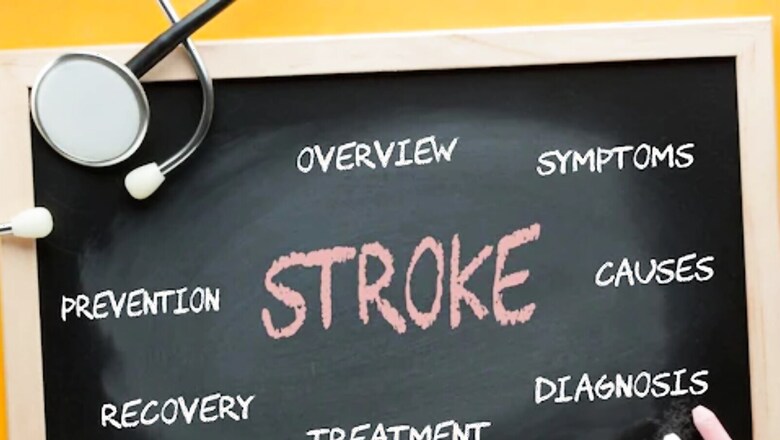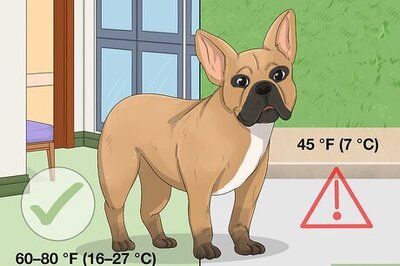
views
Each year, World Stroke Day is observed on October 29, to increase awareness and drive action on stroke around the world. It’s important to raise awareness on what a stroke is, what are its symptoms and how to avoid one.
For the unversed, when a blood vessel in the brain ruptures and bleeds, or when there’s a blockage in the blood supply to the brain, a person experiences a stroke. The rupture or blockage prevents blood and oxygen from reaching the brain’s tissues.
“A stroke occurs when a blood vessel in the brain gets blocked or breaks open, reducing blood and oxygen supply to the brain tissues. Some brain cells cannot function properly and eventually die within minutes due to lack of oxygen and nutrients. This is a very serious condition which needs immediate medical attention. However, the most important thing to understand is that stroke is a preventable disease," says Dr. Tarun Sharma Director Brain & Spine Surgery unit, Marengo QRG Hospital, Faridabad
There are many risk factors for stroke such as high blood pressure, diabetes, tobacco use, heavy alcohol use, sedentary lifestyle, cardiac disease and history of a previous stroke.
“Always remember, delay in treatment can increase the risk of temporary or permanent disability or it can be fatal. Therefore, Stroke is considered as one of the leading causes of death," adds Dr Sharma.
There are two major types of strokes: Ischemic stroke is caused by a blocked artery, on the other hand, hemorrhagic stroke occurs when an artery leaks or ruptures. This can result from high blood pressure, overuse of blood-thinners or anticoagulant drugs or abnormal formations of blood vessels such as aneurysms and AVMs.
Don’t overlook the warning signs of stroke:
- Paralysis of muscles of the face, arms or legs , drooping of face , difficulty in raising an arm or difficulty in walking
- Sudden weakness on the one side of the body or one hand or one leg
- Face Drooping-Face becomes crooked
- Sudden and severe headache
- Vomiting
- Dizziness
- Become unconscious
- Eye Problems- Can’t see with one or two eyes
- Arm Numbness
- Slurred Speech- Can’t speak clearly
To diagnose the type of strokes, CT or MRI of brain should be done immediately. Other tests like blood tests, electrocardiogram (ECG) & echocardiography, carotid Doppler or cerebral angiography may be advised.
What Should One Do When Experiencing a Stroke
When a stroke occurs, the patient should be immediately rushed to a nearby hospital which is equipped to handle such patients in other words a ‘stroke’ ready hospital. “Upon reaching the emergency, a CT Scan of the head of the patient should be done immediately at the hospital. Proper diagnosis within the first few hours after the onset of the stroke symptoms should be done. The most definite treatment is endovascular thrombectomy," says Dr. Vikas Gupta Director, Neurosurgery Department, Kailash Deepak Hospital Delhi.
In simple language, it means removing the blood clot under the guidance of the image which will enable proper flow of the blood to the brain. Since 2015, a new treatment has come which is called mechanical thrombectomy. “In that case, we take the patient directly to the cath lab and open up the artery which is blocked," adds Dr Gupta.
Raising awareness about stroke is really important as a patient might fall down, paralyzed and might not be able to speak. In such cases, it is important that someone nearby should be competent to recognize the symptoms and help immediately. People at large should be educated about the symptoms of a stroke.
“A patient might be losing balance, speech, sometimes losing eye sight because the most important bottom line is that these people do not have pain. It’s a painless weakness. The first hour is considered to be the most crucial because stroke patients have a high chance of survival and prevention of long-term brain damage. The patient should be rushed to a stroke ready hospital where this kind of treatment is possible. where they should have a CT scan, cath lab and preferably an expert (neurointerventionalist)," opines Dr Gupta.
Dr Gupta reveals things to keep in mind to minimise the risk of a stroke:
- Eating seasonal fruits and vegetables can help lower the risk of a stroke as these are naturally low in fat and calories, but rich in fiber. Fruits and veggies also contain essential nutrients like potassium, fiber, folate, vitamin A and vitamin C.
- Potassium rich foods like white potatoes, bananas, tomatoes, prunes, melon and soybeans can help keep your blood pressure under normal range which is considered as one of the leading risk factors of stroke.
- Food high in magnesium such as spinach also helps minimize the risk of stroke. You should have at least two servings of fruits and include seasonal vegetables on a daily basis to cut the risk of a stroke and maintain a healthy weight.
- Consumption of fish which are high in omega-3 fatty acids, can also play a key role in maintaining your blood pressure and cholesterol health.
- Whole grains are loaded with fiber, vitamin B (including folate and thiamine), magnesium and iron which can help minimize the chances of a stroke. Therefore, choosing whole grain bread and cereal, oatmeal and brown rice is recommended. Eat whole grain bread instead of refined white bread.
- Opt for low-fat dairy products such as no-fat milk, yogurt and cheese which can manage Type 2 diabetes and high blood pressure and lower risk of a stroke.
- Refrain from eating high-cholesterol foods popularly known as fast foods like burgers, cheese, and ice cream can increase the risk of stroke.
- Exercise plays a key role in minimizing several stroke risk factors of stroke such as hypertension, diabetes, obesity, cholesterol and stress. Twenty minutes of brisk walking at least four times a week is considered to be a good exercise. It helps keep the blood sugar under check. It also keeps your heart healthy.
- Small everyday activities like walking instead of taking the car, taking the stairs instead of the elevator, gardening and housework help you to stay healthy and lower your risk of having a stroke.
Read all the Latest Lifestyle News here
















Comments
0 comment